Learning Outcomes
After this course learners will be able to:
- Describe how rechargeable battery technology is used in Starkey's rechargeable hearing devices.
- List what styles and technology levels are available with a rechargeable option.
- Describe the estimated battery life and recharge times for Starkey's rechargeable devices.
Introduction and Overview
My name is Doctor Luis Camacho. I am a senior audiologist with the Education and Training Department at Starkey Hearing Technologies. Thank you for joining us for today's session, The Evolution of Rechargeables. Through the course of this presentation, we are going to take a look Starkey's latest lithium ion rechargeable technology. We will review the Starkey products and styles that are available in the rechargeable technology, as well as all of the features in those particular devices and the accessories that can be used with those hearing aids.
To begin, I'd like you to participate in a little exercise. Think about all of the devices in your house that use a standard, disposable battery. Your list might include items such as a wrist watch, the TV remote control, a flashlight, certain toys for children, smoke detectors. Some of the items on this list are potentially rechargeable. You may wear a smartwatch, like an Apple Watch or one of the Samsung watches, which are rechargeable. Also, the remote control I use at home is for my Apple TV, and it is rechargeable as well. It may have been difficult for you to even think of items that use a standard disposable battery.
If we reverse that process, let's think about all the rechargeable devices or items in your home. There are likely many items that pop into your head instantly. In this day and age, we constantly have things plugged in for recharging, such as electric toothbrushes, facial cleansing brushes, razors, hairdryers, vacuum cleaners, power tools. The obvious items that come to mind are cell phones, tablets, laptops, Bluetooth headphones. The list could go on and on and on. Clearly, over the last 10 years or so, many common items that we use have become rechargeable, including hearing aid technology.
Evolution of Rechargeable Technology
Rechargeable technology in the hearing aid industry has existed for about 25 years. Unfortunately, these devices were large and not very attractive. In addition, the charge would only last four or five hours. This was before the days of digital technology, before the days of streaming, before the days of wireless CROS devices. In reality, rechargeable technology for hearing aids wasn't truly viable until the last three to five years, because of the daily performance requirements that patients expect out of their hearing aids. When you couple that with the power demands of today's digital technology (such as streaming, advanced noise management, CROS technology, connectivity to phones), all of these things require a decent amount of power. It's amazing that today, there is a lithium ion rechargeable device that does all of this and the patient doesn't need to worry about the battery lasting all day because it's going to do that without any concerns as long as they've been charging up their devices. As I've been talking to professionals and patients around the world, this is something that patients demand and expect from their hearing aids. They wonder why, when most everything else they use can be recharged, haven't hearing aids been rechargeable until now? Patients expect that performance and functionality in modern, sophisticated hearing aids as well. We're excited to inform you that we now have rechargeable technology in our latest hearing technology.
Why Rechargeable?
Why should we offer rechargeable technology to patients? Through a variety of data collecting techniques (surveys, questionnaires, market research, etc.), we have identified six key components as to why rechargeability is a high demand feature.
- Top requested feature
- Accommodates daily power demand, even with streaming
- Environmentally sound
- Ease of use
- Cost-effective
- Convenience
First, rechargeability is the top requested feature from prospective hearing aid wearers. With today's lithium ion technology, on a fully charged device, your patients are easily going to get through the day and still have some reserve, even with the demands of streaming and connectivity to smart devices. In addition, we're all becoming more environmentally sound, and not throwing away batteries every five to seven days means less waste in the landfill.
The last three components go hand in hand. rechargeable hearing aids offer ease of use and convenience for patients that have a difficult time changing their batteries due to vision or dexterity issues. Even if you're working with a 312 battery, they are still small enough that it can be difficult to position the battery into the hearing aid correctly. Rechargeables are easy to use in terms of intuitive placement in the charging stand, which makes it convenient for the patient. They don't have to worry about running out of batteries and needing to buy more online or at the store. As long as they know that they've got their charger with them or at home plugged in, they're good to go. Lastly, rechargeability is a cost-effective component. Although the hearing aids are slightly more expensive (due to the integration of the lithium ion battery into the hearing aid), in the long run, a rechargeable device is going to be less expensive compared to buying zinc-air batteries for five years. There are a lot of reasons why rechargeables have suddenly become the go-to for many patients and hearing professionals.
In a 2015 MarkeTrak study, they surveyed a group of non-hearing aid wearers (i.e., prospective patients who knew they had a hearing loss or that they could benefit from hearing help sometime in the near future). These people were asked what features or applications in a hearing aid would motivate them to take action and obtain hearing health help. According to the study, 31% of those surveyed stated that rechargeable hearing aids would be a key component in their decision to get hearing help; 20% indicated that rechargeable batteries would be a motivating factor. rechargeability is in demand, not only for your existing patients who are upgrading or wanting the latest technology, but for patients who are contemplating a hearing aid evaluation for the first time. Rechargeability is one of the key components that might sway them to make the decision to get help with their hearing.
LivioAI
I'm going to play a quick video to introduce Livio AI rechargeable.

This is a receiver in the canal rechargeable device, or RIC R (Figure 1). From a battery size perspective, it resembles our standard RIC 312 device but uses lithium ion technology. Also pictured in Figure 1 are our two charging options: the All-in-One Starkey Hearing Technologies (SHT) Charger and the Mini Turbo Charger.
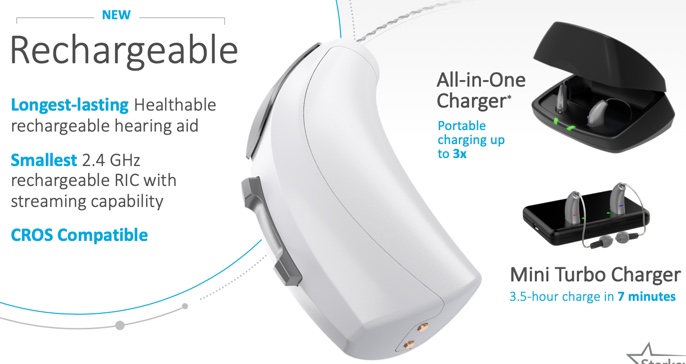
Figure 1. LIVIO AI RIC rechargeable device.
Figure 2 shows an overview of RIC R features and Livio AI technology. Rechargeability is available in our Healthable Livio AI technology, as well as in all five technology tiers of the Livio (1000, 1200, 1600, 2000 and 2400). This is the smallest, 2.4 GHz lithium ion rechargeable RIC with streaming capability, smartphone connectivity, etc. It is CROS compatible as well. It comes with our standard All-in-One Starkey Hearing Technologies charger, but for your "on-the-go" patients, we also offer our Mini Turbo Charger, which can turbo charge a set of hearing aids, giving them three and a half hours of additional life in a seven-minute charge. We will discuss charging options and features shortly.
With Livio as well as Livio AI, we're running on our Thrive platform (i.e., our 2.4 GHz and NFMI dual radio system with wireless programming capability). The RIC R has our Hearing Reality features, as well as integration of the new Self-Check system so you can run a quick diagnostic on the hardware of the devices. The RIC R is compatible with all of our 2.4 GHz wireless accessories. It has integrated tinnitus technology, the programmable rocker switch, available telecoil, an IP rating of 68, and matrices from 40 all the way up to 70 gain. With our RIC R, we offer you a full feature device, both Livio and Livio AI with lithium ion rechargeable technology. The biggest takeaway I want you to have is the lithium ion technology is pretty much standard these days. Your patients should not have any concerns about the devices lasting a full day. They will last a full day. And perhaps most importantly, these are the best sounding hearing aids available to your patients.
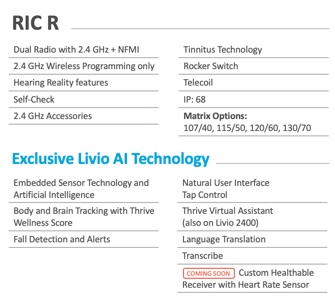
Figure 2. Overview of RIC R features and Livio AI technology.
The Livio AI is the world's only Healthable hearing technology. It has embedded sensor technology with integrated artificial intelligence. It allows a patient to track body and brain wellness with their Thrive wellness score within the Thrive mobile app. Fall detection is now standard on all Livio AI devices. We have our natural user interface with tap control, as well as the Thrive Virtual Assistant. We also offer live voice-to-text language translation integrated into the app. Coming soon, we will have the custom Healthable Receiver with our heart rate sensor and monitor built into it. All of this technology is available and compatible with the lithium ion rechargeable Livio AI 2400.
Hearing Reality Featuring Spatial Speech Enhancement
Spatial Speech Enhancement is a NEW binaural noise reduction feature available only on Livio AI and Livio. It only engages for loud noise inputs when it would provide the most benefit to the listener. This uses the NFMI radio system to continuously stream audio between the two devices for a comparison of sounds coming from areas around the user's head. The goal is to reduce steady-state and dynamic background noises, especially noises that are coming from the sides, to improve sound quality, to improve comfort in background noise, and to maximize clarity as we're integrating with the other noise management features.
In 2018, an independent study conducted by Delta Senselab compared patient preference for hearing aid sound quality in background noise. Listeners compared the sound quality of various manufacturers high-end technology with their premier noise management features. Results showed a significant preference for Starkey’s Livio AI when listening in background noise. Starkey Livio AI provided a quieter and more comfortable listening experience for participants, thanks to the processing power of the Thrive platform, the spatial speech enhancement algorithm, our fast acting speech in noise algorithm, as well as updates and improvements to a variety of other features in the devices.
Our feedback canceler has been improved to further reduce artifacts and distortion potential. Our output limiting compression has been improved to provide a fuller perception of loudness, a more natural sound quality. With these devices, we've also introduced a brand new transient noise reduction algorithm that quickly attenuates for sudden, abrupt loud sounds and makes those comfortable to listen to without distorting the normal or natural environmental or speech sounds. When we combine all of these features in our Livio and Livio AI devices, including the rechargeable products, we do have the best sounding hearing aids and the most comfortable sounding hearing aids in the industry.
Exclusive Livio AI Technology
With the launch of Livio AI 2400, we are proud to present the industry's only Healthable technology. Our exclusive Livio AI technology includes the following:
- Embedded Sensor Technology and Artificial Intelligence
- Body and Brain Tracking with Thrive Wellness Score
- Natural User Interface Tap Control
- Language Translation
- Fall Detection and Alerts
- Thrive Assistant (also on Livio 2400)
- Transcribe
- Custom Healthable Receivers with Heart Rate Sensor (will be available on Livio AI RIC R)
This particular receiver will only be compatible with the rechargeable lithium ion Livio AI devices. The battery requirements for the heart rate sensor do require the use of a rechargeable device. This is just another example of where rechargeable technology is becoming the preferred form of powering hearing aids because as we move forward with advanced technologies, above and beyond streaming and noise management algorithms (e.g., advanced sensor technology), they're going to require a different level of power and lithium ion rechargeables are ideal for that. If you have a patient that you think would be an ideal candidate for a heart rate monitoring, they have to go with the lithium ion Livio AI rechargeable technology. With that heart rate sensor, we'll be the only manufacturer to offer patients the ability to take an on demand, beats per minute heart rate measurement, as well as to do an on demand heart rate recovery measurement (i.e., measuring the heart rate at a targeted level during exercise and comparing that heart rate to the level after a rest period - a standard way of measuring heart health). The custom healthable receivers with heart rate sensor will be available very soon on Livio AI RIC R (lithium ion rechargeable devices).
Chargers and Battery Life
With both Livio and Livio AI devices, fully charged with one hour of streaming on average through the day, the patient should expect 24 hours of battery life. If we increase streaming time to four hours, the battery life is approximately 22 hours. A typical wearer of hearing devices is going to easily get through a day on a full charge, as not many patients wear their hearing aids longer than 22 hours straight. A full, normal day's use is easily attainable with the rechargeable Livio or Livio AI devices.
In terms of charging time, a 15-minute charge will result in two hours of battery life onto the lithium ion hearing aids. A 30-minute charge would give 4.3 hours of use. One hour of charge time would give the patient nine hours of use, and finally, two and a half hours of charge time gives that full 24 hours. Even though we would recommend that patients put their hearing aids in their charger at night while they're asleep, it doesn't require that entire amount of time.
It is important to note that the lithium ion rechargeable Livios and Livio AI are only wirelessly programmable (Figure 3). We can use our proprietary 2.4 GHz programmer or the universal 2.4 GHz NoahLink programmer (plugged into Inspire, of course) to program the devices wirelessly.
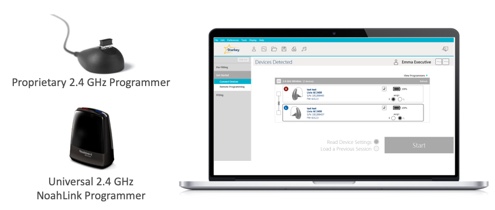
Figure 3. Wireless programming.
When you are working with the lithium ion Livio and Livio AI, we do have a programmable rocker switch in the user control configuration. You do have the ability to configure that rocker switch to function as a power off button. The hearing aids will automatically turn off when placed in the charger and automatically turn on when removed from the charger. However, there may be times when the patient wants to turn off the hearing aids and they don't have their charger with them (e.g., taking a shower at the gym). They would need to simply push and hold on the rocker switch and that will power down the devices. They can be powered back on with a quick short press on the top part of the rocker switch. Programming the rocker switch as a power on/off button allows the patient to turn their hearing aids off and on without the charger if necessary. This is not an ear to ear function. The wearer does have to press the button on both hearing aids individually if they want the power on/off functionality using the rocker switch.
Next, we will watch a brief video here showing functionality of the charger.

When you put the hearing aids into the charger, they power off. When you took them out, they will automatically power on. It's very easy and intuitive. Or, if you want the flexibility of using the rocker switch, you can do that as well by programming it from the user control configuration screen in the Inspire programming software.
In the data log, average battery life will not appear for rechargeable devices. Estimations regarding battery life are based on an average over time, but the hearing aids may be at different levels of battery strength when the patient decides to charge them and/or will rarely, if ever, fully deplete. As a result, there is no way to obtain an accurate value related to average battery life. That being said, information on average daily use and average time streaming will still be provided, which can give you an idea of how long they can expect that full charge to last. If you see that they're not doing any streaming at all, you know that they should be able to get 24 hours. But if you have a patient who's sitting in front of the TV and streaming for eight hours a day, you'll be able to counsel that a full charge is going to last less than what we would expect because they're streaming more than the average person.
Starkey Hearing Technologies (SHT) Charger
For the Livio and Livio AI devices, we offer a charger that we have named the Starkey Hearing Technologies Charger (Figure 4). For those of you that had been working with Muse IQ lithium ion, the SHT charger has the same form factor as the Muse IQ, or what we were calling the Synergy charger. The brand new SHT charger is compatible with the Livio and Livio AI rechargeable devices, as well as with the Muse IQ hearing aids. As such, if you were to need a new charging case for a set of older Muse IQ lithium ion devices, you would receive this new version with the latest firmware and the latest technology. It looks and feels the same and it will work with the Muse IQ devices as well. However, the Livio AI and Livio rechargeables will not work in the old Muse IQ or Synergy charger. As a professional, if you have a Muse IQ charger in your office that you use to charge up hearing aids before fittings, or to do a charge if a patient comes in and their batteries aren't fully charged, be aware that that will not be compatible with Livio and Livio AI because of different firmware and firmware requirements. You'll want to make sure you have a newer Starkey Hearing Technologies charger in the office for those purposes.
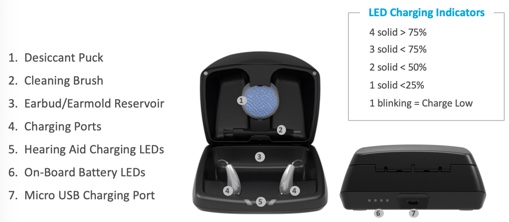
Figure 4. SHT Charger and features.
The form factor of the SHT Charger is very much the same as the Synergy charger. It is portable for travel. The lid snaps shut and stays closed securely. Again, you can fully charge a set of dead hearing aids in two and a half hours. The hearing aids are automatically turned on and off when placing in or taking out of the charger. The charger has an integrated desiccant, dry aid puck, a place to put the cleaning tool and brush. There are individual charging ports for the left and the right hearing aids.
There are LED lights in the front that will flash green when the hearing aids are charging, and will remain solid green when they are fully charged. On the back, there is a micro USB port to plug into the wall outlet, and four dot indicator lights to indicate the charge of the onboard battery. Again, this has a built in battery for mobile charging. If you see four solid lights, there is between 75 to 100% of battery life remaining. Three solid lights indicate 50 to 75% of battery life. Two solid lights mean there is a 25 to 50% charge remaining. One light indicates 25% or less. If you see one blinking light, that means the onboard battery is about to die.
Now, we will watch another brief video so you can see how the lights operate on the charger.

If the lights are red, that means something's not right. There may be a problem with the connection between the hearing aids and the charger. It could be that they are dirty. What we would recommend is to take the hearing aids out, wipe them down, and put them back in. Hopefully, the light will turn green. If not, the patient is going to contact you. If the charger is unplugged when you put the hearing aids into the charger, both the front and back LED lights will stay lit up for 10 seconds and then they will go blank or turn off to maintain the onboard battery life as long as possible. If you put the hearing aids in while the charger is unplugged and you didn't get a quick good look at the lights on the back or the front, simply take the hearing aids out, put them back in, and you've got another 10 seconds to take a look at the LED lights to see the status of either the onboard battery or the charging status of the hearing aids themselves.
Again, the new Starkey Hearing Technologies Charger has that onboard battery. It can charge the hearing aids in exactly the same manner unplugged as it can when it's plugged in. If the hearing aid batteries are completely dead and you've got battery life with the SHT charger's onboard battery, you can fully charge those hearing aids in two and a half hours. With a full onboard battery (i.e., four dot lights), you can recharge the Livio AI and Livio devices three full times, which offers the patient the flexibility of being away from a wall plug if you need it. We sometimes refer to this as the "weekend mode". If you went away for the weekend and you didn't have access to plug your micro USB into a wall outlet, if your SHT charger had a full battery, you can charge those hearing aids three times and get through the full weekend.
The recommended use and care instructions of the Livio AI hearing aids and the charger are similar to those for any hearing aid. Depending on the patient's general use of the devices, the batteries themselves in the hearing aids and in the charger should hold their full capacity anywhere from three to five years. Other care instructions are as follows:
- Store the aids and charger in a clean, dry location away from excess heat
- Fully charge the hearing aids every night
- Keep the charger lid closed to preserve the desiccant puck
Here are some useful tips to help maximize the performance of the devices:
- Fully charge the hearing aids every day. Although we have up to a 24-hour battery life on a full charge, best practice is to fully charge the hearing aids every day.
- Store in a clean, dry location away from excess heat (e.g., a window sill or car). Unplug the charger when it will not be in use.
- Charge the hearing aids after a low battery warning. The hearing aids should be charged after hearing the “low-battery” indicator. Remember, with as little as 15 minutes of charging time, your patients will be able to get an additional 2 hours of battery life to get them through those important meetings and conversations.
- Lithium Ion Batteries do not have a charging memory. The battery will not wear out from fully charging every night. Fully discharging the battery is not necessary between charges and will not harm the battery.
The charger comes with a disposable blue plastic desiccant puck. Once it becomes saturated with moisture, the puck will turn white to visually indicate that it's time to replace it. We would recommend that the patient put their hearing aids in the charger every single night and close the lid. That will maximize the moisture absorption out of the hearing aids. The life of the puck depends on the environment. It might be longer in the winter and shorter in the summer. It depends on the humidity levels where you live. Pucks are easy to order from the E-store and are very easy to change. You just snap it in or out.

When you order the Livio and Livio AI rechargeable devices, you get everything that you need, including:
- Hearing aids (shipped in the charger)
- Receivers
- Right/Left Indicators
- HearClear (one 8 pack per 2 devices)
- Charger
- Desiccant Puck
- Pouch
- Cleaning Tool
- Operations Manual
- USB-to-micro USB Charge Cable
- Wall Wort
Mini Turbo Charger
We are excited about the new Mini Turbo Charger (Figure 5). It's about the size of a credit card, and is less than the thickness of a deck of standard playing cards. It also has a carrying case that it slides into to protect the connectors for the hearing aids. This is designed as a pocket-sized charger and is easy to carry around. Again, the functionality of the Mini Turbo Charger is similar to that of the standard SHT charger that comes with the hearing aids, but the Mini Turbo offers some additional benefits for patients that may potentially need a quick charge.
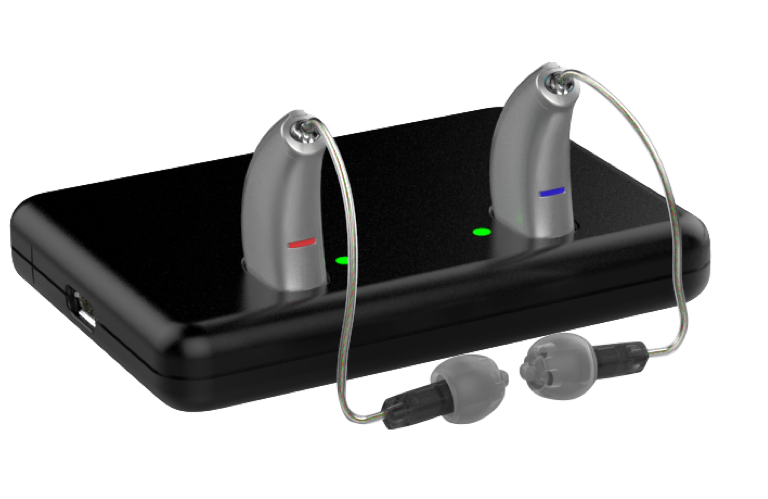
Figure 5. Mini Turbo Charger.
Similar to the standard charger, the Mini Turbo Charger has an onboard, built-in battery, ideal for use when you don't have the ability to plug in somewhere. If the onboard battery has a full charge, it can fully charge a set of Livio and Livio AI devices four times. Obviously it's portable, and it works when it's plugged in or on the go. It also has a double tap feature, meaning if you physically double tap on the charger itself, that will cause the LED lights to appear so you can see the status of charging or the status of the onboard battery. It has a metal slip case that you can slide the charger into and it protects the charging ports. This too, will work with the brand new Livio, Livio AI and is backward compatible with the Muse IQ rechargeable devices.
The Mini Turbo Charger also has LED lights which indicate battery life status as follows:
- 4 solid lights > 75%
- 3 solid lights < 75%
- 2 solid lights < 50%
- 1 solid light <25%
- 1 blinking light = Charge Low
The reason we call it the Turbo Charger is that it has the ability to give the hearing aids a 20% charge (i.e., three and a half hours of use) in only seven minutes. This turbo charging rate will occur automatically if the hearing aids are at or below 20% charge and you put them into the charger. During turbocharging, all four of the LED lights will blink to let you know the turbocharging is occurring. Turbocharge only happens if the hearing aids are below 20% of their life and you put them into the Turbo Charger. This is ideal for BiCROS users. The turbocharge functionality will probably not occur that often because of the life of the charge. Again, we're talking about hearing aids that last typically 22 to 24 hours on a full charge. Most people aren't going to get down to 20% of that through a typical, normal day. But when it does occur, you've got that ability to get those three and a half hours of life on seven minutes of charge. You can do a full charge with the Turbo Charger in three hours. You can do four full charges with a full life onboard battery for the Mini Turbo Charger. It has some similar functionality as the standard charger, as well as the benefits of the turbocharging.
We will view a brief video on the Turbo Charger so you can see what it looks like.

You could potentially get a red light if something is not functioning properly. We'd recommend cleaning the hearing aid contacts or the battery charger contacts, and trying it again. Again, the same care and use instructions apply to the Mini Turbo Charger as with the standard charger and standard hearing aids. Keep them clean, keep them dry, wipe out those ports as needed with a dry, clean cloth.
As you can see, the Mini Turbo Charger offers some additional flexibility, particularly for patients that are on the go and for those who are heavy streamers (e.g., using their phone a lot, using the remote microphone in the classroom, etc.).
Livio AI/Livio R CROS System
As I mentioned earlier, the Livio AI and Livio rechargeable devices are also CROS compatible. CROS/BiCROS is available in Livio AI 2400, as well as in Livio 2400, 2000 and 1600 technology. We're using our NFMI radio for the CROS functionality and with a CROS/BiCROS system rechargeable, we expect about 14 hours of life. That will get most CROS/BiCROS users through the day. The Turbo Charger might be ideal for your heavy BiCROS user, for someone who wears the hearing aids longer than 14 hours a day. The Turbo Charger might also benefit people who stream a lot, above and beyond just the transmitter streaming (e.g., talking on the phone, using an accessory, etc.). As they get to the last few hours of the day of using their hearing aids, it would be ideal for them to plug into the Mini Turbo Charger to get them through to the end of the day. That's something to consider as you're talking to your BiCROS users.
With the CROS system, we do also have a auto shutdown for the transmitter. This is a battery saving functionality. If the transmitter is out of range of the receiver for more than 30 minutes, the transmitter will shut itself down. There are occasions where people take off their transmitter and disconnect from their receiver. If they leave it sitting there and disconnected for longer than 30 minutes, the transmitter is going to shut down so that it's not draining the battery. All you have to do to power it back on is tap on or press the user control and it'll reconnect to the receiver.
Wireless Accessories
Of course, all of the rechargeable devices, whether they're Livio, Livio AI or the CROS/BiCROS systems, are compatible with all of our 2.4 GHz wireless accessories (Figure 6).
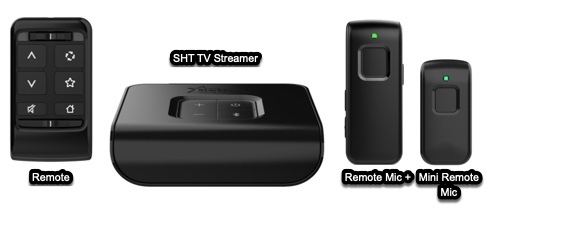
Figure 6. Wireless accessories compatible with Livio AI and Livio R.
The Mini Remote Microphone is the newest streaming accessory in the 2.4GHz family. Offering simple, single-purpose functionality to enhance speech understanding in one-on-one communication environments, the Mini Remote Microphone is compatible with all new Livio AI/Livio hearing aids. Coming soon, a firmware update will become available that will enable Mini Remote Microphone compatibility with previously released Livio AI and Livio hearing aids. It is rechargeable, easy to use, easy to pair to the devices, and offers great functionality in terms of providing improved signal to noise ratio.
I'm going to show a quick video of the pairing process. With rechargeables, one of the things you have to remember is that the most standard way to turn them on is to take them out of the charger. Then double click the home button on the mini mic until you see the red and blue flashing lights. At that point, you should see a green solid light for each hearing aid as it pairs.

The reason I wanted to show that video is because if you are pairing anything with rechargeable devices, whether it's to the patient's phone or to one of these wireless accessories, you do need to go through a power up cycle. The easiest way to go through that power up cycle is by putting them in the charger and taking them out of the charger. That activates that power up cycle and puts them into search/pairing mode.
In addition to the brand new Mini Remote Mic, we still have our Remote Microphone +. It has a remote mic feature, telecoil feature, DAI function, can stream from any Blue-tooth audio capable device, including Android phones, and you can line-in devices too. We also have our Starkey Hearing Technologies TV streamer. It can be easily plugged into a TV and then paired to the devices for direct to hearing aid audio streaming from the television. This is compatible with an infinite number of Livio or Livio AI devices for streaming. Finally, the new 2.4 GHz remote control is compatible with the new Livio/Livio AI hearing aids. The remote is ideal for patients that want a different way to control their hearing aids outside of the user controls on board the devices or the Thrive mobile app.
Summary and Conclusion
After today's presentation, you hopefully have a good grasp of the fact that rechargeables are becoming the standard in the hearing aid industry. Your patients want them, they like the convenience of it, and it's more cost-effective in the long run. With lithium ion batteries, there are no concerns with the hearing aids dying halfway through the day, although your heavy use patients do have the option of turbocharging, to provide them an end-of-the-day boost.
The following is a list of all the other AudiologyOnline courses related to our Evolution of the Hearing Revolution launch:
- Evolution of the Hearing Revolution
- Inspire 2019: Evolution of Programming Software
- Fall Detection
- Lasting Connections: Starkey Hearing Technologies 2.4 GHz Wireless Accessories
- Hearing Reality Sound Quality Features
- Livio AI CROS System
- Hearing Care Anywhere: Revolution in Remote Programming
- Fall Detection and Alerts
There are a lot of ways for you to learn more about our biggest launch in the history of Starkey and our Healthable Hearing technology. There are quick tips within Inspire on our Inspire Online page. We offer a wealth of information at StarkeyPro.com, as well as a dedicated micro site, StarkeyPro.com/Livio-AI. Any information you need on both Livio and Livio AI products, accessories, including many of the videos that we showed today, are available there. This micro site is a key resource for you as you're embracing the Evolution of the Hearing Revolution. Thank you for your time and attention today.
Citation
Camacho, L. (2019). Evolution of rechargeables. AudiologyOnline, Article 24446. Retrieved from https://www.audiologyonline.com


